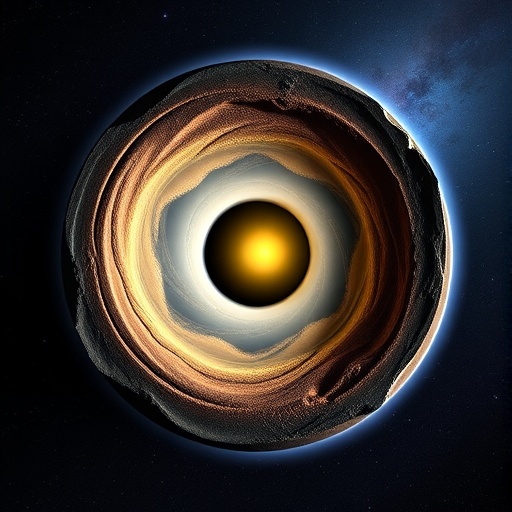The traditional view of planet formation, characterized by smooth, flat discs of cosmic dust where celestial bodies coalesce, is undergoing a revolutionary shift. A new study, published in the renowned Astrophysical Journal Letters, has unveiled a startling discovery regarding the nature of protoplanetary discs—the very nurseries where planets are born. An international coalition of scientists, harnessing the advanced observational capabilities of the Atacama Large Millimetre/submillimetre Array (ALMA), has found compelling evidence that many of these discs are not the serene structures once thought, but rather subtly warped entities, introducing complexity into our understanding of planetary formation.
The significance of this revelation lies not only in the unexpected shapes of these discs but also in the implications such warping carries for planet formation dynamics. The slight twists in the disc plane, often measuring just a few degrees, draw striking parallels to the nuanced inclinations exhibited by the planets within our own Solar System. This finding implies that the initial conditions under which planetary systems form could be far less orderly than previously theorized, potentially reshaping our understanding of how planets evolve from these chaotic beginnings to structured, stable orbits.
Dr. Andrew Winter, a Royal Society University Research Fellow in astronomy at Queen Mary University of London and the leading author of the study, emphasized the groundbreaking nature of their results. He stated that the detection of warps in protoplanetary discs suggests a paradigm shift in how these entities are conceptualized. The discovery is especially intriguing given the resemblance between the observed warps and the inclinations of the planets orbiting our sun.
Dr. Myriam Benisty, director of the Planet and Star Formation Department at the Max Planck Institute for Astronomy, further elaborated on the ramifications of the findings. She noted that the revelations from the exoALMA project have brought to light large-scale structures within planet-forming discs that defy conventional expectations. The discovery of warp-like structures poses a substantial challenge to the existing frameworks of orderly planet formation and invites further inquiry into the underlying mechanisms at play.
The scientific team employed meticulous analysis techniques centered around Doppler shifts. These minuscule changes in the radio waves emitted by carbon monoxide (CO) molecules within the discs serve as a cosmic speedometer, unveiling detailed motions of the gas. This thorough examination was part of the extensive ALMA initiative known as exoALMA, where the researchers adeptly mapped the velocity distribution of gas within the discs. The intricate modeling conducted to analyze these patterns allowed them to discern when specific regions were subtly tilted, leading to insights into the presence and nature of warps within the discs.
Such modest misalignments raise intriguing questions about their role in the star and planet formation processes. Dr. Winter highlighted that these findings may indicate that warped discs are a common outcome during the formation phases of stars and their accompanying planetary systems. The implications of this research extend beyond merely observing the discs; they inspire fresh inquiries into the causes of these warps, whether they arise from the gravitational influences of unseen companion stars or from the intricate and often chaotic interactions between gas and dust particles.
The subtle disc warps, tilting by as little as half a degree to two degrees, provide a compelling explanation for many large-scale dynamical patterns seen in the gas movement across the discs. These findings even suggest that such warps might contribute to the formation of striking spiral structures and variations in gas temperature within these celestial nurseries. If the dynamics of the disc gas are substantially influenced by these warps, this fundamentally alters our comprehension of critical elements such as turbulence and the processes governing material transfer within the discs, which are essential for planet formation.
Moreover, researchers noted a fascinating link between the warping of the disc and the material being accreted by the young star at its center. This connection hints at a complex interplay between the innermost regions, where the star is actively drawing in substance, and the outer areas designated for planet formation. This dynamic suggests a potentially significant feedback mechanism, where the star’s growth influences the structure and behavior of the protoplanetary disc that surrounds it.
This groundbreaking research shines a light on the intricate and often surprising realities of planet formation, offering a revised cosmic blueprint for how we perceive the emergence of diverse planetary systems beyond our solar neighborhood. As astronomers and planetary scientists delve deeper into the complexities revealed by exoALMA, the research lays the groundwork for future innovations and understandings regarding the formation and evolution of not only our solar system but also the myriad other systems scattered throughout the cosmos.
In conclusion, the revelations stemming from this study prompt a reevaluation of our knowledge regarding the formative stages of planetary systems. With the potential for further findings to refine or challenge existing theories, researchers are excited about what these warped structures might reveal regarding the formation of our universe’s myriad worlds. As we continue to unravel the mysteries surrounding protoplanetary discs, we find ourselves on the brink of new astronomical insights that could reshape our cosmic narrative.
This collaborative research effort is a testament to the power of international scientific partnerships, involving esteemed institutions such as the Max-Planck Institute for Astronomy, University of Florida, and many others dedicated to the quest for knowledge. As we stand at the cusp of a new understanding of the cosmos, the journey into the heart of protoplanetary discs promises not only to redefine our comprehension of planet formation but also to ignite the imaginations of future astronomers and astrophysicists seeking to unveil the mysteries of the universe.
Subject of Research: Protoplanetary discs and their warping effects on planet formation
Article Title: exoALMA XVIII. Interpreting large scale kinematic structures as moderate warping
News Publication Date: 27-Aug-2025
Web References:
References:
Image Credits: Dr A Winter, Queen Mary University of London
Keywords
Protoplanetary discs, exoALMA, planet formation, warping, astrophysics, Doppler shifts, cosmic dust, ALMA, celestial bodies, gravitational interactions.




